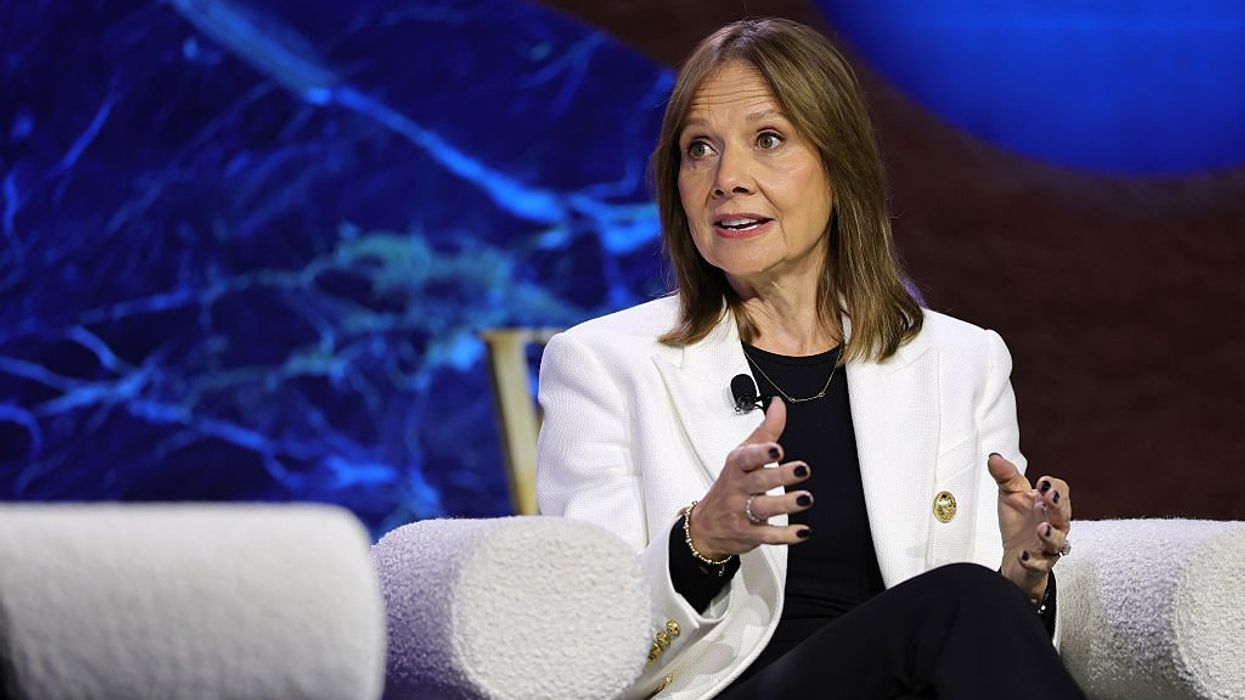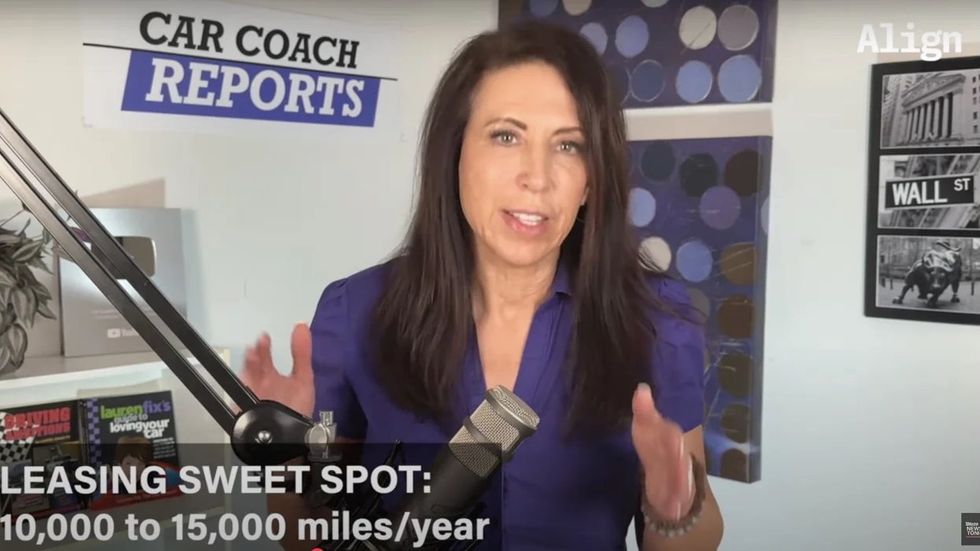
Dia Dipasupil/Getty Images

What exactly is CEO Mary Barra doing — and how could it affect you?
Americans aren't buying them and Trump wants to take away their $7,500 tax credit — but General Motors CEO Mary Barra still thinks electric vehicles are the future.
Never mind the $888 million her own company just poured into gas-powered V-8 engines — Barra seems to think they'll go the way of the dinosaurs sooner rather than later.
Car brands need to pick a lane: Build what consumers want, not what bureaucrats demand.
"I see a path to all EV," she announced at the Wall Street Journal's Future of Everything conference late last month. "I do believe we'll get there because I think the vehicles are better.”
Barra's commitment to phasing out gasoline-powered vehicles by 2035 has made GM one of the frontrunners in the EV race.
Meanwhile, actual consumers still bring up the rear. A recent AAA survey reveals that 63% of Americans are skeptical about EVs, citing high costs, higher insurance premiums, and inadequate charging infrastructure.
Then, there's that almost billon-dollar investment in gas-guzzlers. Something tells us Barra's not exactly putting her money where her mouth is.
Can she have it both ways? As some automakers resist the all-EV push and others cling to outdated mandates, the auto industry is at a crossroads. Let’s unpack the contradictory strategy, consumer hesitancy, and the brands charting their own paths in this high-stakes debate.
This could impact the economy, your driving choices, and where you spend your money..
RELATED: Introducing 'Quick Fix': Practical answers to all your car questions

Barra has positioned GM as an EV leader, boasting, “We have more EVs in the market right now than anyone else in this country.” GM’s lineup includes nine electric models, such as the Chevrolet Equinox EV, Cadillac Escalade IQ, and GMC Hummer EV, with four more planned.
The Equinox EV, priced around $35,000, aims to make EVs accessible to everyone. To support this, GM has invested $35 billion through 2025 in EV and autonomous vehicle development, including a battery cells factory outside Nashville.
In contrast, last December, GM announced it would sell its stake in the Ultium Cells plant in Lansing, Michigan, to LG Energy Solution. Partnerships with EVgo and Pilot Company aim to expand fast-charging stations, with Barra asserting, “Charging is just going to continue to get better.” GM has dropped the “Ultium” brand name for EV batteries.
Yet, GM’s actions tell a different story. In a surprising move, the company announced an $888 million investment in its Tonawanda Propulsion plant, outside of Buffalo, New York, to produce the sixth generation of V-8 engines for full-size trucks and SUVs.
These engines promise stronger performance, better fuel economy, and lower emissions through new combustion and thermal management innovations.
This follows a $579 million investment in January 2023 to upgrade the Flint Engine plant for the same V-8 engines, marking Tonawanda as the second facility to produce them.
Barra defended the move, saying, “Our significant investments in GM’s Tonawanda Propulsion plant show our commitment to strengthening American manufacturing and supporting jobs in the U.S.” She added that the Buffalo plant, operational for 87 years, will deliver “world-class trucks and SUVs to our customers for years to come.”
This dual strategy raises questions. Is GM truly committed to an all-electric future, or is Barra hedging her bets to meet consumer demand for gas-powered vehicles?
Consumers might argue she’s trying to have it both ways — pushing a government-favored EV agenda while quietly acknowledging that Americans still want gas trucks and SUVs. Barra’s claim of “choice” feels like a nod to market freedom, but it’s hard to ignore the influence of past presidential administrations’ heavy-handed EV mandates.
If GM is serious about consumer choice, why not let the market — not bureaucrats — set the pace?
Americans aren’t buying the EV hype. AAA’s latest survey shows only 16% of U.S. adults are “very likely” or “likely” to buy an EV as their next car, the lowest interest since 2019. Meanwhile, 63% are “unlikely” or “very unlikely” to go electric, up from 51% last year.
Greg Brannon, AAA’s director of automotive engineering, noted, “While the automotive industry is committed to long-term electrification and providing a diverse range of models, underlying consumer hesitation remains.”
The reasons are clear: high battery repair costs (62%) and purchase price (59%) top the list. AAA’s "Your Driving Costs 2024" analysis confirms EVs’ higher upfront costs, despite long-term savings. Additionally, 57% see EVs as unsuitable for long-distance travel, 56% cite insufficient public charging stations, and 55% fear range anxiety. Safety concerns trouble 31%, 27% struggle with home charging (especially in apartments), and 12% worry about losing tax credits.
These numbers reflect a market rejecting top-down mandates. Consumers aren’t anti-EV — they’re anti-being told what to buy when the infrastructure and affordability aren’t there. Barra’s EV push aligns with policies mandated by past administrations, but her V-8 investment suggests she knows the market isn’t ready to abandon gas. This contradiction exposes a flaw in centrally planned transitions: You can’t force consumers to want what doesn’t work for them.
While GM straddles both worlds, other automakers are rejecting the all-EV narrative.
Toyota has been vocal about its skepticism, focusing on hybrids like the Prius, which deliver fuel efficiency without charging hassles. Toyota’s investment in hydrogen fuel cells for semi-trucks positions it as a pioneer in alternatives to battery EVs.
RELATED: Toyota, Jeep, and the big emissions scam

Mazda, with its MX-30 EV, prioritizes gas engine improvements and hybrids, citing battery production costs and environmental concerns.
Subaru, offering the Solterra EV, emphasizes hybrids and awaits better charging infrastructure.
Hyundai is navigating the shifting auto landscape with a pragmatic strategy that prioritizes consumer demand over government mandates, a move drivers can applaud. The company’s $7.6 billion Metaplant in Georgia is now expanding to include hybrids, with Kia models joining the lineup in 2026.
Hyundai’s focus on hybrids, like the 2026 Palisade, reflects growing demand for fuel-efficient options that don’t rely on sparse charging infrastructure. Meanwhile, Hyundai continues to produce gas-powered vehicles, recognizing that internal combustion engines still dominate consumer preferences in many markets.
Unlike GM’s Barra, who pushes an all-EV future while investing in gas engines, Hyundai’s approach avoids hypocrisy by openly embracing a mix of EVs, hybrids, and gas vehicles. This flexibility shields Hyundai from policy swings — like potential tariff hikes or the loss of EV subsidies — while giving drivers the freedom to choose what fits their lives, not what bureaucrats dictate.
Stellantis, parent of Jeep, Dodge, Ram, and Chrysler, balances plug-in hybrids like the Jeep Wrangler 4XE with gas vehicles, catering to diverse consumer needs.
These brands are listening to the market, not bureaucrats. By offering hybrids and gas options, they’re giving consumers what they want — freedom to choose — while GM’s $888 million V-8 investment suggests even Barra knows gas isn’t going away soon. In addition, GM currently does not offer a hybrid powertrain in its vehicles.
This resistance to EV mandates reflects buyers' common sense: Let the market, not the government, decide what drives America.
Barra’s vision for 2035 is ambitious, but her actions betray uncertainty. GM’s EV efforts for affordable models, batteries, and charging partnerships are serious, but the $1.4 billion combined investment in V-8 engines for Tonawanda and Flint shows she’s not ready to abandon gas.
AAA’s survey proves consumers aren’t convinced, and brands like Toyota, Stellantis, Mazda, Hyundai, and others are betting on hybrids to bridge the gap. Car brands need to pick a lane: Build what consumers want, not what bureaucrats demand.
If you’re eyeing an EV, the lineup is diverse, but AAA’s data urges caution. Can you charge reliably? Can you afford the cost? Does the range work for your life? If not, you’re among the 63% holding back — and that’s your right.
You're in the driver's seat; where you go should be up to you — not bureaucrats.
Lauren Fix